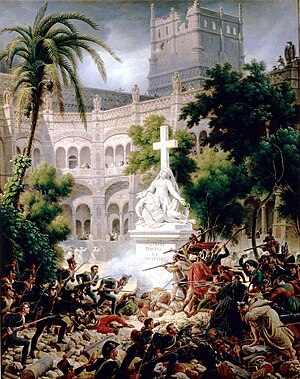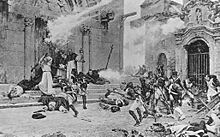
Back Belagerung von Saragossa (1809) German Δεύτερη Πολιορκία της Σαραγόσα Greek Sitio de Zaragoza (1809) Spanish Siège de Saragosse (1809) French Secondo assedio di Saragozza Italian Beleg van Zaragoza (1809) Dutch Oblężenie Saragossy (1809) Polish Cerco de Saragoça Portuguese Asediul Zaragozei (1809) Romanian Вторая осада Сарагосы Russian
This article needs additional citations for verification. (December 2013) |
| Second siege of Zaragoza | |||||||
|---|---|---|---|---|---|---|---|
| Part of the Peninsular War | |||||||
 Assaut du monastère de Santa Engracia by Louis-François, Baron Lejeune. Depicts the fighting of February 8, 1809. Oil on canvas. | |||||||
| |||||||
| Belligerents | |||||||
|
| |||||||
| Commanders and leaders | |||||||
|
| |||||||
| Strength | |||||||
| 50,000 regulars[1] |
30,000 regulars and militia[1] 1,400 cavalry 160 guns 20,000 Spanish civilians[2] | ||||||
| Casualties and losses | |||||||
|
6,000 dead or wounded in combat[1] 6,000 died of disease[1] |
30,000 military[1] 34,000 civilians dead[1][3] | ||||||
Peninsular War: Napoleon's invasion
current battle



The siege of Zaragoza was the French capture of the Spanish city of Zaragoza (also known as Saragossa) in 1809 during the Peninsular War. It was particularly noted for its brutality.[4] The city was heavily outnumbered against the French. However, the desperate resistance put up by the Army of Reserve and its civilian allies had been heroic: a great part of the city lay in ruins, the garrison had suffered 24,000 deaths being augmented by 30,000 civilians dead.[5]
- ^ a b c d e f g h Bodart 1908, p. 393.
- ^ militari 2020.
- ^ georgian 2017.
- ^ Haythornthwaite 1996, chapter 4.
- ^ Esdaile 2003, pp. 159–163.
